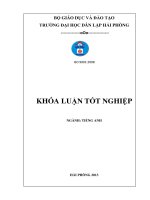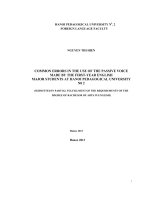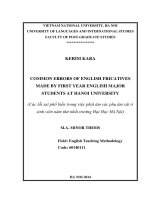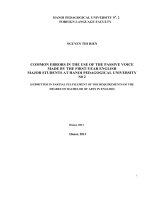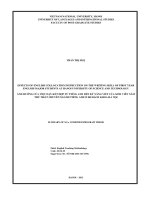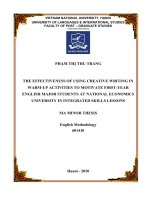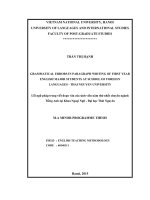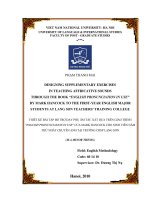Grammatical errors in paragraph writing of first year English major students at School of Foreign Languages – Thai Nguyen University
Bạn đang xem bản rút gọn của tài liệu. Xem và tải ngay bản đầy đủ của tài liệu tại đây (444.47 KB, 69 trang )
VIETNAM NATIONAL UNIVERSITY, HANOI
UNIVERSITY OF LANGUAGES AND INTERNATIONAL STUDIES
FACULTY OF POST-GRADUATE STUDIES
*********************
TRẦN THỊ HẠNH
GRAMMATICAL ERRORS IN PARAGRAPH WRITING OF FIRST YEAR
ENGLISH MAJOR STUDENTS AT SCHOOL OF FOREIGN
LANGUAGES - THAI NGUYEN UNIVERSITY
Lỗi ngữ pháp trong viết đoạn văn của sinh viên năm thứ nhất chuyên ngành
Tiếng Anh tại Khoa Ngoại Ngữ - Đại học Thái Nguyên
M.A MINOR PROGRAMME THESIS
FIELD : ENGLISH TEACHING METHODOLOGY
CODE : 60140111
Hanoi, 2015
VIETNAM NATIONAL UNIVERSITY, HANOI
UNIVERSITY OF LANGUAGES AND INTERNATIONAL STUDIES
FACULTY OF POST-GRADUATE STUDIES
*********************
TRẦN THỊ HẠNH
GRAMMATICAL ERRORS IN PARAGRAPH WRITING OF FIRST YEAR
ENGLISH MAJOR STUDENTS AT SCHOOL OF FOREIGN
LANGUAGES - THAI NGUYEN UNIVERSITY
Lỗi ngữ pháp trong viết đoạn văn của sinh viên năm thứ nhất chuyên ngành
Tiếng Anh tại Khoa Ngoại Ngữ - Đại học Thái Nguyên
M.A MINOR PROGRAMME THESIS
FIELD
: ENGLISH TEACHING METHODOLOGY
CODE
: 60140111
SUPERVISOR
: PHẠM ĐĂNG BÌNH, Ph.D
Hanoi, 2015
DECLARATION
I certify my authorship of the study report entitled
“Common Grammatical Errors in Paragraph Writing of First Year English
Major Students at School of Foreign Languages – Thai Nguyen University”
is the result of my own research for the Degree of Master of Arts at University of
Languages and International Studies- VNU, Hanoi, and this thesis is in total
fulfillment of the requirements for the Degree Master of Arts.
Thái Nguyên, ngày 6 tháng 4 năm 2015
Ký tên
Trần Thị Hạnh
i
ACKNOWLEDGEMENTS
I would like to express my many thanks to people who have assisted me
when I carried out the research.
To my supervisor Dr. Pham Dang Binh, I owe a special debt of gratitude for
his profound knowledge, helpful support, and enthusiasm, which are of almost
importance to the achievement of my study.
I would like to convey my thanks to all my teachers of Post-Graduate Studies
Department who have supported mw with a lot of knowledge. I owe a special note
of gratitude to all my colleagues for their invaluable comments, assistance, and
advice during the time I was completing my study.
I am extremely thankful to all the participants who provided me with rich
and detailed data for the study and lent breadth and values to the research findings.
I also wish to express my sincere gratitude and appreciation to my mother,
my father, family members, and friends whose prayers, love and best wishes were a
source of inspiration, encouragements, and motivation for me to complete this
research.
Finally, I would like to thank my readers for their interests and comments on
this thesis.
ii
ABSTRACT
This paper studies common grammatical errors in paragraph writing
committed by first year English major students at School of Foreign Languages
– Thai Nguyen University (SFL-TNU) and the causes of these errors. To
achieve the desired aims of current study, the author combined both qualitative
and quantitative methods, including the instrument namely students’ writing
analysis. The participants in the research were fifty first year English major
students at SFL- TNU.
Research results show that first year English major students at SFL- TNU
often commit errors in sentence structure, verb usage, preposition usage and
singular/plural nouns. Besides, the main causes of these errors are mother tongue
interference, overgeneralization, ignorance of rule restrictions, incomplete
application of rules and false concepts hypothesized; in which interference of native
language and overgeneralization are the most common ones. In order to minimize
these errors, it is suggested that teachers help students practice writing and correct
their writings effectively by suitable and flexible techniques.
iii
TABLE OF CONTENTS
DECLARATION .................................................................................................... i
ACKNOWLEDGEMENTS ..................................................................................ii
ABSTRACT ......................................................................................................... iii
TABLE OF CONTENTS ..................................................................................... iv
LIST OF ABBREVIATIONS ............................................................................. vii
LIST OF TABLES AND FIGURES ..................................................................viii
PART A– INTRODUCTION ................................................................................ 1
1. Identification of the problem and rationale of the study ................................... 1
2. Aims of the study ............................................................................................ 2
3. Research questions .......................................................................................... 2
4. Scope of the study ........................................................................................... 3
5. Significance of the study ................................................................................. 3
6. Structure of the study....................................................................................... 3
PART B - DEVELOPMENT CHAPTER I – LITERATURE REVIEW ........... 5
1. Grammar ......................................................................................................... 5
1.1. Definitions of grammar ................................................................................ 5
1.2. Roles of grammar in foreign language teaching ............................................ 5
2.Writing ............................................................................................................. 6
3. Paragraph ........................................................................................................ 7
3.1. Definitions of paragraph ............................................................................... 7
3.2. Structure of a paragraph................................................................................ 7
4. Errors in foreign language teaching ................................................................. 8
4.1. Definitions of errors ..................................................................................... 8
4.2. Errors versus mistakes .................................................................................. 8
4.3. Types of errors ........................................................................................... 10
4.4. Sources of errors......................................................................................... 12
4.4.1. Mother tongue interference ...................................................................... 12
iv
4.4.2. Overgeneralization .................................................................................. 13
4.4.3. Ignorance of rule restriction ..................................................................... 14
4.4.4. Incomplete application of rules ................................................................ 14
4.4.5. False concepts hypothesized .................................................................... 15
5. Error analysis ................................................................................................ 15
5.1. Definitions of error analysis........................................................................ 15
5.2. Significance of error analysis...................................................................... 16
5.3. Analysis of composition errors ................................................................... 17
5.3.1. Procedure for error analysis ..................................................................... 17
5.3.2. Common ESL writing errors .................................................................... 18
5.3.3. Types of grammatical errors in ESL writing ............................................ 19
CHAPTER II – RESEARCH METHODOLOGY ............................................. 21
1. Research setting and participants ................................................................... 21
1.1. Research setting.......................................................................................... 21
1.2. Participants ................................................................................................. 21
2. Data collection instruments ........................................................................... 21
2.1. Reasons for choosing students’ writing task ............................................... 22
2.2. Description of students’ writing task........................................................... 22
3. Data collection procedure .............................................................................. 23
4. Data analysis ................................................................................................. 23
4.2. Classification of errors................................................................................ 25
4.3. Explanation of errors .................................................................................. 25
4.4. Evaluation of errors .................................................................................... 26
CHAPTER III – FINDINGS AND DISCUSSION ............................................. 27
3.1. Findings ..................................................................................................... 27
3.2. Discussion .................................................................................................. 31
3.2.1. The most common grammatical errors committed by first year English
major students at SFL- TNU in paragraph writing ............................................. 31
3.2.1.1. Sentence structure errors ....................................................................... 31
v
3.2.1.2. Verb errors............................................................................................ 33
3.2.1.3. Preposition errors.................................................................................. 35
3.1.2.4. Noun errors ........................................................................................... 36
3.2.2. The causes of errors made by the first year English major students at SFLTNU in paragraph writing ................................................................................. 36
3.2.2.2. Overgeneralization................................................................................ 38
3.2.2.3. Ignorance of rule restrictions ................................................................ 39
3.2.2.4. Incomplete application of rules ............................................................. 40
3.2.2.5. False concepts hypothesized ................................................................. 40
PART C- CONCLUSION ................................................................................... 41
1. Summary of the study .................................................................................... 41
2. Limitations of the study ................................................................................. 42
3. Suggestions for further studies....................................................................... 42
4. Recommendations ......................................................................................... 43
REFERENCES .................................................................................................... 45
APPENDIX ............................................................................................................ I
vi
LIST OF ABBREVIATIONS
EA: Error Analysis
L1: The First Language
L2: The Second Language
SFL- TNU: School of Foreign Languages – Thai Nguyen University
vii
LIST OF TABLES AND FIGURES
Table 2.1: Error marking symbols
Table 2. 2: Error classification
Table 3.1; Number and frequency of grammatical errors in paragraph writing by
types and by groups
Figure 3.1: Frequency of grammatical errors in paragraph writing by groups
Table 3.2: Frequency of each grammatical error type
Figure 3.2: Frequency of each grammatical error type
viii
PART A– INTRODUCTION
1. Identification of the problem and rationale of the study
English has become one of the most dominant media in many fields like
economy, politics and culture. Obviously, English is the most popular foreign
language taught in Vietnam. This language brings Vietnam closer to other countries
in the world. It is the key to access the latest achievements of science and
technology. Therefore, it is very essential for Vietnamese to learn English in order
to satisfy the needs of society in modern world.
The goal of teaching and learning foreign language is improving learners’
communicative competence. In order to acquire this competence, learners must be
good at four skills in English: reading, writing, listening, and speaking; among
which writing is considered a very important proficiency. Besides speaking, writing
is a productive skill. It helps people communicate with others through messages.
Furthermore, writing makes contribution to enhance other skills in languages and
learners’ logical way of thinking, thus facilitating them in their profession. It is
undeniable that writing plays the utmost role in learning English.
The most effective way to access learners’ writing proficiency is examining
their writing papers. There have been a variety of studies regarding analysis of
learners’ writing. For instance, Darus (2009) conducted the analysis of the written
English essays by secondary school students in Malaysia; Abeywickrama (2010)
implemented the study on errors in English writing of Sinlaha speaking
undergraduates. In Vietnam, analysis of students’ writing has also been paid a lot of
attention. Hoang Thi Hong Hai (2003) studied grammatical and textual errors in
paragraphs by the second year students at English Department – College of Foreign
languages – Vietnam National University. In 2012 M.A thesis, Do Van Lap
analyzed errors made by tenth graders at Thuan Thanh II High School in their
English writing. Besides, many other researches on this field have been carried out.
1
These studies have been implemented on different learning contexts as well as
different learners.
At School of Foreign Languages – Thai Nguyen University (SFL – TNU),
English is the most dominant language to be taught, and writing has been paid a lot
of attention immediately from the first year of learning course. However, as a
lecturer at SFL – TNU for four years, the author find that most of the first year
English major students at SFL often make writing errors, especially in grammar. A
number of techniques have been proposed in order to improve students’ writing
skill. Nevertheless, at SFL – TNU, there has been little concern to common errors in
students’ writing, why they commit errors and how to prevent and reduce these
errors. Hence, with a view to solve the problem above, there arises a need of a
research on “Grammatical Errors in Paragraph Writing of First Year English
Major Students at School of Foreign Languages – Thai Nguyen University”.
2. Aims of the study
This research is carried out with the following aims:
Investigate the grammatical errors in paragraph writing of first year
English major students at SFL – TNU and the causes of these errors.
Suggest some possible implications in teaching and learning writing at
SFL - TNU.
3. Research questions
To reach the aims mentioned above, the researcher supposes two research
questions as follows:
1. What are the common grammatical errors committed by first year English
major students in writing paragraph?
2. What are the major causes of these errors?
2
4. Scope of the study
Due to the limited time and the restricted scope of a minor thesis, the study
focuses on exploring students’ errors in writing short paragraph because first year
English major students at SFL – TNU are taught to write paragraph. In addition, this
study could not cover all types of errors. The researcher just focus on a number of
grammatical errors committed by first year English major students at SFL –TNU
under the study of their writing, thereby proposing some pedagogical suggestions
for teaching and learning writing skill at SFL – TNU.
5. Significance of the study
As one of the under-researched issues in teaching writing skill for students in
Vietnam, the present study will, first and foremost, help students to improve their
writing skill, and then make certain contributions to students, teachers and
educators, as well as researchers in the related fields.
Firstly, as for students, this study will help them realize how much progress
they made towards the target language, especially in written proficiency. They are
able to understand deeply about types of errors in writing and adjust effective
learning methods in studying English writing skill.
Secondly, the study is expected to help teachers in particular and educators in
general understand the nature of errors, which is useful for them in teaching writing skill.
Last but not least, the research will serve as a foundation for further related
studies. Other researchers may also take the strengths and weaknesses of the study
into account to better theirs.
6. Structure of the study
The study consists of three parts, organized as followed:
Part A – Introduction
This part gives information about the topic of the research, the reason for choosing
this topic, the aims, research questions, scope, significance, and structure of the
study.
Part B – Development
3
Chapter I –Literature Review
Various perspectives on grammar, paragraph writing, errors, error analysis (EA) are
discussed in order to provide a theoretical background of the study.
Chapter II – Methodology
This chapter mentions context and participants of the study, research instruments,
data collection procedure and data analysis methods.
Chapter III – Findings and Discussions
The data collected will be analyzed in order to give answers to the research
questions.
Part C – Conclusion
This part deals with summary of the study. Limitations of the study and suggestions
for further research and some recommendations are also presented here.
4
PART B - DEVELOPMENT
CHAPTER I – LITERATURE REVIEW
1. Grammar
1.1. Definitions of grammar
According to Palmer (1971, p. 11) “Grammar is a device that …. specifies in
infinite set of well- formed sentences and assigns to each of them one or more
structure descriptions”. Besides, Ur (1990, p. 4) considers grammar as “the way
language manipulates and combine words or bits of words in order to form longer
units of meanings”. Salkie (1995, p. 9) states that “grammar deals mainly with the
structures of individual sentences.
In a word, grammar is basically about how words combine to form
sentences. It is regarded as sets of rules and examples dealing with
the syntax and word structures of a language. In other words, it is defined as the set
of rules for constructing words, phrases and sentences in a particular language.
1.2. Roles of grammar in foreign language teaching
Grammar plays an important role in language teaching. Palmer (1971, p. 10)
states that “it is grammar that makes language so essentially a human
characteristics”. Thus it is possible to say that a learner who “knows grammar” is
the one who has mastered and can apply these rules to express himself or herself in
what would be considered acceptable language forms. According to Ur (1990, p. 4)
“a knowledge of grammatical rules is essential for the master of language”. A
learner can not use word unless he knows how to put them together.
Nowadays, when communicative language teaching is widely applied,
grammar still has a very important role. Richards (1985) points out that there is no
actual empirical evidence that proves communicative language teaching classrooms
produce better language learners than traditional language classrooms do.
Moreover, Canale (1981) insists that grammatical competence is one component of
communicative competence. In addition, it is undoubtable that learners of a foreign
5
language without any formal grammar instruction during the basic language
teaching stage can never achieve high proficiency in the target language.
In short, grammar is very necessary in the process of mastering the language.
It is essential if advanced proficiency is desired and a high level of literacy is
required in teaching and learning a language.
2.Writing
Writing has been defined in a variety of ways by different researchers;
therefore, it is very difficult to choose which is the most exact and trustworthy.
According to Flower (1984, p. 16) “writing is simply the act of expressing
what you think or saying what you mean”’. Meanwhile, Byrne (1988, p.1) considers
writing as “art of forming graphic symbols, that is, letters or combination of letters”.
In fact, writing, however, is far more complicated process than the
combination of graphic symbols. It is “a process of transforming the materials
discovered by research inspiration, accident, trial and error, or whatever into a
message with a definite meaning “(Lannon, 1989, p. 9). Lannon states that writing
is “a process of deliberate decision”.
At a high level, writing is defined as a complex process which involves a
number of separate skills. Hedge (1988, p.1) states that “… effective writing
requires a number of things: a high degree of organization in the development of
idea and information; a high degree of accuracy so that there is no ambiguity of
meaning; the use of complex grammatical devices for focus and emphasis; and a
careful choice of vocabulary, grammatical pattern, and sentence structure…” Hedge
(2000) considers the process of writing as thinking and discovery.
Furthermore, writing is regarded as a productive and taught language skill
which is “difficult to acquire” (Tribble, 1996, p. 3). The essence of writing is choice
and writing is considered as the means of communication in a way that is
“profound, or funny, or provocative, or highly persuasive” (Veit, Gould & Clifford,
2001)
6
In conclusion, writing is a productive and complex skill. It is an art of
communication with certain groups of audience. It requires the ability to
communicate in target language and to produce text in order to express oneself
efficiently; therefore, It is obvious that writing requires conscious effort and
practice
3. Paragraph
3.1. Definitions of paragraph
Up to now, several definitions of paragraph have been proposed. For some
people, paragraph is simply a course of indention that is beginning a little to the
right of the margin. In other view, “paragraphing is indicated by a skipped line and
a new sentence beginning at the left hand margin” (Robert & Wilson, 1980, p.52).
In a word, these definitions of paragraph tend to focus on punctuation.
There is another trend to define paragraph. Oshima & Hogue (1996, p. 2)
defines paragraph as “… a basic unit of organization in writing in which a group of
sentences develop one main idea”. Rooks (1988, p.4) states “a paragraph is a group
of sentences which logically develops one subject”. In short, paragraph can be
defined as a group of sentences that develop one main idea.
3.2. Structure of a paragraph
There are three main parts of paragraph: topic sentence, supporting sentences
and concluding sentence.
Topic sentence is the most important in the paragraph. According to Oshima
& Hogue (1996, p.104) “it is called the topic sentence because it tell the reader what
the topic of the paragraph is”. In other words, it tells the readers what they are going
to read. A topic sentence has two parts: topic and controlling idea. The topic tells
the readers what the paragraph is about. The controlling idea limits the topic.
According tp Oshima & Hogue (1996) the topic sentence may be the first or the last
sentence in a paragraph.
7
Supporting sentences support or prove the idea stated in the topic sentence.
That is they explain the topic sentence by giving facts, reasons, examples, statistics,
and quotation.
Concluding sentence is the final part of the paragraph. It “signals the end of
the paragraph and leaves the readers with important points to remember” (Oshima
& Hogue, 1996, p. 36). A good concluding sentence should: restate the main idea in
the topic sentence and include writer’s comments or opinions about the topic.
4. Errors in foreign language teaching
4.1. Definitions of errors
Errors are always the central concern in foreign language teaching. in the
early 70’s, researches into error by Corder (1967), Selinker (1972), Richards (1973),
Dulay and Burt (1974) have demonstrated that “learner errors are indicative of both
the state of learner’s knowledge and of the ways in which the second language is
being learnt” (Lee, 1990, p. 56). Errors are defined as “systematic deviations from
the norms of language being learnt” (Cunning Worth, 1987, p.5). According to
Richards (1989), the term “error” is identified as a faulty use of a linguistic item
which shows incomplete learning. Brown (2007, p.258) describes error as “…
noticeable derivation from the adult grammar of a native speaker, reflects the
competence of the learner” and “… reveals a portion of learners’ competence in the
target language”. Besides, Seah (1981, p. 12) states that “errors are derivations from
the norm of the target language whether phonological, syntactic or semantic”.
Errors are defined by many linguists; however, the term “error” here is
understood basing on Richards (1989) and Brown (2007). In short, it is the faulty
use of target language and it reflects learners’ incomplete competence in the target
language.
4.2. Errors versus mistakes
Brown (2007, p. 257) states that “in order to analyze learner language in an
appropriate perspective, it is crucial to make a distinction between errors and
mistakes. Chomsky (1965) makes distinction between “competence” and
8
“performance” to distinguish between “errors of competence” and “errors of
performance” or “mistakes”. In the later paper, Corder (1979, p. 168) states “an
error is lack of competence and mistake is performance deviant”. Also, Brown
(2007, p. 257) proposes that “a mistake refers to a performance error that is either a
random guess or a “slip”, in that it is a failure to utilize a known system correctly”.
Next Ellis (1997, p.17) states “errors reflect gaps in a learners’ knowledge; they
occur because the learner does not know what is correct. Mistakes reflect occasional
lapses in performance, they occur because the learner is unable to perform what he
or she knows”.
Corder (1967, 1974), James (1998) and Brown (2007) reveal that a criterion
that helps us to draw distinction between errors and mistakes is the selfcorrectability. These researchers state that a mistake can be self-corrected, but an
error can not. According to Hunbbard et al (1984) errors are caused by lack of
language while mistakes are made accidentally due to “lapses of memory, confusion
or slips of tongue”. He also states that learners can correct themselves their mistakes
but not errors.
In addition, Corder (1974) distinguishes between “systematic errors” and
“non- systematic errors” which are called “mistakes”. He argues that a mistake is a
derivation of the norms of the language but is not systematic. It means that the use
of the norm of the language is sometimes right and sometimes wrong. In contrast,
an error is systematic. It is made repeatedly “when people do not fully command
some institutionalized language system” (Corder, 1974).
In short, it can be concluded that mistakes are often non-systematic and are
“… made by lack of attention, fatigue, carelessness or other aspects of
performance” (Richards et al, 1985, p. 6). Therefore, learners can avoid as well as
correct them if they pay attention to mistakes. On the contrary, errors are systematic
and caused by learners’’ lack of competence in target language. It is difficult for
learners to correct their errors.
9
4.3. Types of errors
The classification of errors has been proposed by many linguists. Richards
(1971) classifies errors into three categories: interference errors, intralingual errors,
and developmental errors. According to him, interference errors result from the use
of the elements from one language while speaking/writing another. Intralingual
errors reflect general characteristics of the rule learning such as faulty
generalization, incomplete application of rules and failure to learn conditions under
which rules applied. Developmental errors occur when learners attempt to build up
hypothesis about the target language on the basis of limited experiences.
Dulay and Burt (1974, cited in Haydari, 2012) proposes three broad
categories of errors: developmental errors (errors that are similar to L1 acquisition),
interference errors (errors that reflect the structure of the L1), and unique errors
(errors that are neither developmental nor interference. In addition, in the 1974
research (cited in Karra, 2006 and Haydari, 2012), Stenson draws attention to
another type of errors – induced errors – which result from incorrect instruction of
the language. Brown (2007, p. 260) discusses distinction between “overt errors” and
“covert errors”. He states that “overtly erroneous utterances are unquestionably
ungrammatical at the sentence level”; “covertly erroneous utterances are
grammatical well-formed at the sentence level but not interpretable within the
context of communication”
On the basis of linguistic level, errors are classified into four major
categories (Lee, 1990): grammatical, discourse, phonological, and lexical errors.
Grammatical errors emphasize on grammatical accuracy more than fluency.
Discourse errors are related to the non-observance of the target language
conventions. Phonological errors are related to incorrect pronunciation, word stress,
and intonation. Lexical errors occur when learners use wrong word class and
inappropriate words.
10
Pham Dang Binh (2013, p.78) points out that there are two kinds of errors
namely “common errors” and “specific errors” as illustrated in the diagram below.
Errors
Common errors
Competence
errors
phonological
lexical
Specific errors
Performance
errors
intralingual
Interference/
interlingual
errors
Cross-cultural
errors
Errors in
communication
strategies
Cross-cultural
errors in language
behaviors
grammatical
Errors in
paralinguistic
behaviors
Diagram 1.1. Types of errors
(According to Pham Dang Binh, 2013, p.78)
In conclusion, errors are classified differently according to many
perspectives by different researchers. With the aim of investigating grammatical
errors committed by students, the author would like to adapt Pham Dang Binh’s
(2013) way of classifying errors and just focus on grammatical errors due to the
scope of the study.
11
4.4. Sources of errors
In 1971, Richards cites four major sources of intralingal errors:
overgeneralization, ignorance of rule restriction, incomplete application of rules,
and false concepts hypothesized. Besides, Schumann and Senton (1974) state three
major causes of errors: incomplete acquisition if the target grammar, exigencies of
learning/teaching situation, and normal problems of language performance.
According to Richards (1974), the sources of errors are the interference of the
learner’s mother tongue and the general characteristics of the rule learning. In the
1992 study, Norrish reports that the causes of errors are carelessness, first language
interference, translation, overgeneralization, incomplete application of rules.
Brown (2007) states four sources of errors: interlingual transfer, intralingual
transfer, context of learning, and communication strategies. Interference transfer is
the negative influence of the mother tongue of the learner. Intralingual transfer is
the negative of items within the target language. Context of learning overlaps both
types of transfer. Brown (2007) proposes five main communication strategies:
avoidance, prefabricated patterns, cognitive and personality style, appeal to
authority and language switch.
In summary, errors can be caused by many different factors. In fact, the
sources of errors are mother tongue influence, overgeneralization, incomplete
application of rules in target language, ignorance of rule restriction and failed
concepts hypothesized. In order to address the answer to the second research
question about the major causes of students’ errors, the explanation of these causes
will be illustrated in more details as follows:
4.4.1. Mother tongue interference
Mother tongue interference is one of the major causes leading to learners’
errors in learning a language. Norrish (1983, p.22) states that mother tongue
interference “… was commonly believed until fairly recently that learning a
language was a matter of habit formation”. Beside forms, meanings and cultural
aspects can also be transferred.
12
Languages differ in many aspects, and the most difference is the way a
shared meaning is realized. Two languages employ different devices to express the
same meaning. It is this distance that may give rise to errors because learners have
tendency to transfer the realization devices of their native language into the foreign
language. For example, Vietnamese students often produce such sentence as “I very
love my mother” instead of “I love my mother very much”. It is common knowledge
that at a certain stage of learning, FL learners are required to produce the new
language. They are forced to perform things even though they do not want or their
competence fails to meet the requirement. It is due to this pressure that learners will
rely on their first language to fulfill the tasks. Undoubtedly, differences between L1
and L2 affect the process of learning a target language. It is the major source of
mother tongue interference.
4.4.2. Overgeneralization
Another possible cause of errors to be mentioned is overgeneralization.
According to Jacobovits (1969, p.55) overgeneralization is “… the application of
previous available strategies in new situations”. More specifically, students base on
their past learning experience to produce deviant structures in the target language.
For example, having been taught to form plural nouns by adding the suffix “s” to
singular nouns, students extend this application even to irregular nouns and produce
such deviated forms as “She has two childs.” or “The cat has just caught three
mouses.”
Richards (1971) regards this type of error as instances of structure blending.
Students automatically apply rules wherein they are not allowed. For instance:
“She will comes back.” instead of “She will come back.”
“It is rains heavily.” despite “It rains heavily.”
Overgeneralization is also linked with redundancy reduction. This happens
when students find that some grammatical aspects are unimportant in conveying the
meaning. It is popular in descriptive writing which students often use simple present
13
tense instead of past tense although actions happened in the past. For example “Last
Sunday we go to the cinema to see a film.”
In short, overgeneralization is regarded as one of the major causes of errors.
It is the result of learners’ processing and making hypotheses about the language.
4.4.3. Ignorance of rule restriction
This type of error involves “… the application of rules to contexts where
they do not apply” (Richards, 1974). He mentions two sources for rule restriction
errors: analogy (the creation of deviant structures from previous experience of
English), and the rote of learning of rules. The example for analogy is that students,
encountering a particular preposition with one type of verb, will attempt to apply
the same preposition with similar verbs by analogy. Having learnt “He said to me
that thing”, students tend to produce “He told to me about that” instead of “He told
me about that”. Besides, the rote of learning of rules also leads to ignorance of rule
restriction. For instance, students are taught to use to-infinitive in the structure of
the verbs such as “ask”, “get”, “order”, and they assume that the structure of the
verb “let” should be “ let + O + to- V” as in the sentence “He let me to go out”.
4.4.4. Incomplete application of rules
This kind of error represents the degree of development of rule required to
produce acceptable sentences. It is typically related to analogy. One of the most
common difficulties is the use of questions in classroom. Responses to questions
require grammatical rules. For example:
Teacher: “What did she tell you?
Student: “She tell me about her boyfriend”
(She told me about her
boyfriend)
Another case is in the use of indirect speech. For example:
Direct speech: He asked me “What did you do last Sunday?”
Indirect speech: He asked me what did I do last Sunday.
(He asked me what I had done the previous Sunday.)
14
4.4.5. False concepts hypothesized
This type of error derives from incorrect comprehension of distinction in the
target language. According to Richards (1974), poor presentation or presentation
based on the contrastive approach should account for the confusion between “come”
and “go” and the use of “was” and “is” as past and present marker respectively. A
number of students tend to produce “He is goes to school” or “It was rained”. In
addition, in stead of saying “Let’s go home now”, they would say “Let’s come home
now.” Another case is the use of “very”, “too” and “so”. For instance:
“He is very tired to do this work”
(He is too tired to do this work)
(He is so tired that he can not do this work)
5. Error analysis
5.1. Definitions of error analysis
The field of EA was established in the 1970s by Corder and colleagues.
Corder (1967, cited in Heydari, 2012) defines “EA attempts to describe learners’
interlanguage. According to Darus (2009, p. 487) “EA is a types of linguistic study
that focuses on the errors learners make”. EA is one of the most influential theories
of second language acquisition. “It is concerned with the analysis of the errors
committed by L2 learners by comparing the learners’ acquired norms with the
target language norms and explaining the identified errors” ( James, 1988. cited
in Sawalmeh, 2013, p. 3). For Crystal (1999, p. 108) “EA in language teaching and
learning is the study of the unacceptable forms produced by someone learning a
language, especially a foreign language”. According to James (2001, p. 62), EA
refers to “the study of linguistic ignorance, the investigation of what people do not
know and how they attempt to cope with their ignorance”. Another definition of
error analysis is given by Brown (1980, cited in Ridha, 2012, p. 26). He defines
error analysis as "the process to observe, analyze, and classify the deviations of the
rules of the second languages and then to reveal the systems operated by learner".
15
